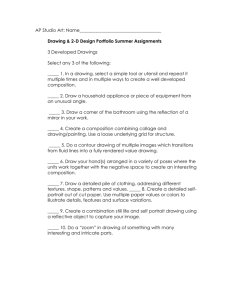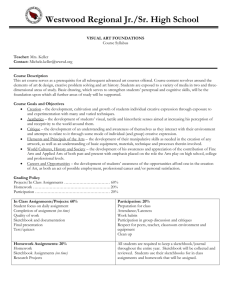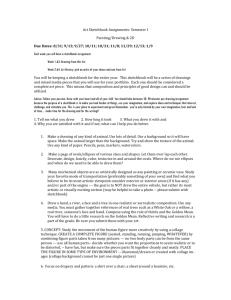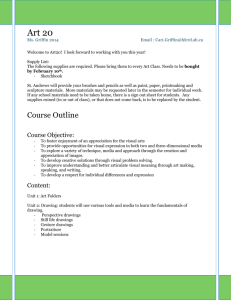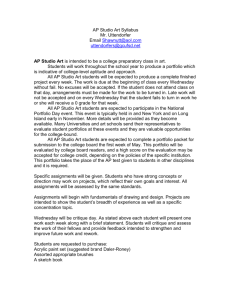AP Studio Art Summer assignments
advertisement
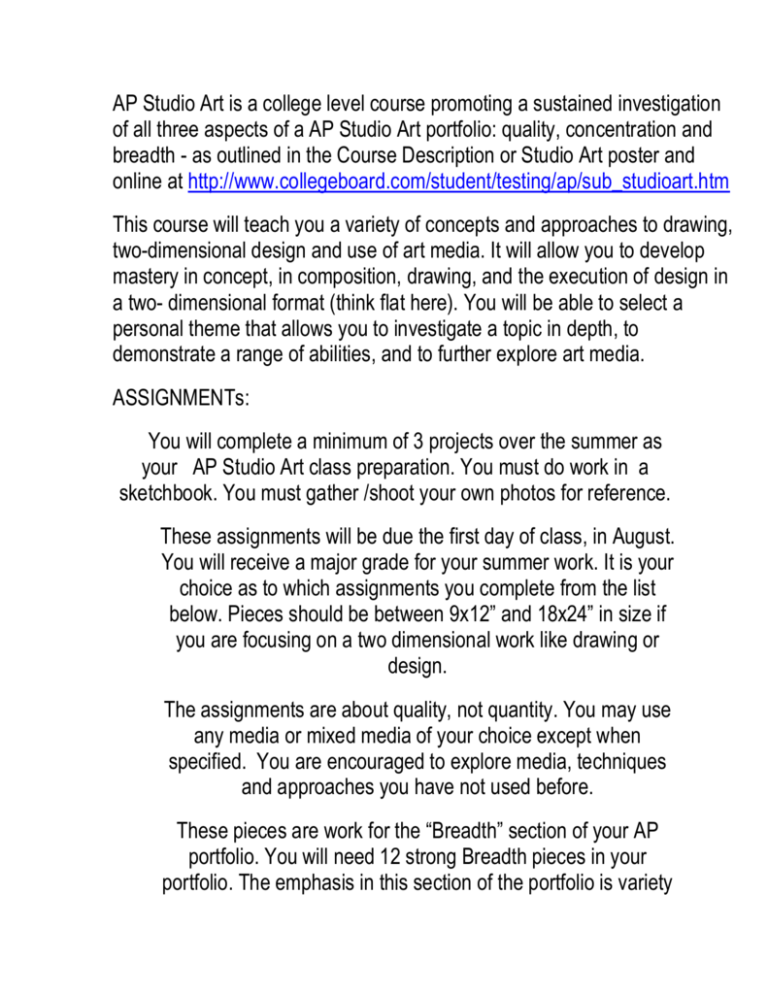
AP Studio Art is a college level course promoting a sustained investigation of all three aspects of a AP Studio Art portfolio: quality, concentration and breadth - as outlined in the Course Description or Studio Art poster and online at http://www.collegeboard.com/student/testing/ap/sub_studioart.htm This course will teach you a variety of concepts and approaches to drawing, two-dimensional design and use of art media. It will allow you to develop mastery in concept, in composition, drawing, and the execution of design in a two- dimensional format (think flat here). You will be able to select a personal theme that allows you to investigate a topic in depth, to demonstrate a range of abilities, and to further explore art media. ASSIGNMENTs: You will complete a minimum of 3 projects over the summer as your AP Studio Art class preparation. You must do work in a sketchbook. You must gather /shoot your own photos for reference. These assignments will be due the first day of class, in August. You will receive a major grade for your summer work. It is your choice as to which assignments you complete from the list below. Pieces should be between 9x12” and 18x24” in size if you are focusing on a two dimensional work like drawing or design. The assignments are about quality, not quantity. You may use any media or mixed media of your choice except when specified. You are encouraged to explore media, techniques and approaches you have not used before. These pieces are work for the “Breadth” section of your AP portfolio. You will need 12 strong Breadth pieces in your portfolio. The emphasis in this section of the portfolio is variety of media, style, approach and subject matter. The Breadth section of the Drawing portfolio MUST include observational drawing. Mixed media including YOUR OWN photography is allowed. Project Choices: A self-portrait expressing a mood. How can you use color to convey that mood? What style will work best for you in this work? Do some research online or at an area museum to see how different artists create self- portraits and what techniques and media they use. Use an odd/extreme angle and consider strong light/dark contrast. Still life arrangement of 3 or more reflective objects. Your goal is to convey convincing representation. Sketch and shade for contrast and drama. Consider doing this as a self-portrait – draw yourself distorted in a shiny object. A drawing of an unusual interior – for example, look inside a closet or cabinet, in the refrigerator, under the car’s hood or inside the medicine cabinet. A still life arrangement of objects representing members of your family – a favorite pair of shoes, a toy etc. You must have at least 3 objects and use an unusual viewpoint or angle. Example-Put the objects on the floor and stand up looking down at them. A close up of a bicycle/tricycle from and unusual angle with strong light/shadow. Do NOT draw the bicycle from the side view. . Expressive landscape – this can be near your home, a place you visit on vacation or one you find on a drive into other areas of Kentucky. Make every effort to work plein air – meaning drawing or painting outdoors. You will have better light and will be able to focus on the color you actually see. Action portrait/figure drawing – have a friend or family member pose for you doing some sort of movement (jumping rope, riding a bike, walking down stairs etc.) Capture the entire sequence of their action in one work or art or a series of photos. How will you portray movement in your work? Look at “Nude Descending a Staircase” by Dada artist Marcel Duchamp to see an example of an action painting. Also see the work of Futurist artists Giacomo Balla and F.T. Marinetti. Place three eggs on a towel or cloth, to create an interesting composition and draw it in pencil. Pay attention to the smoothness of the eggs against the rough quality of the material. Concentrate on the forms of the eggs and uses strong values. Use graphite. You must keep a sketchbook. Sketchbook at least 8 ½ by 11 no larger than 11x14 The sketchbook you keep should be your “new best friend” this summer. You need to carry it with you everyday, everywhere! Open it up first thing in the morning and last thing at night and many times in between. Draw in it, write in it, scribble in it, paint in it, glue things into it, cut the pages, tear the pages, change the way it looks to make it look like your own book. At the end of the summer it should reflect YOU and your experiences throughout the summer. Work in your sketchbook is an ongoing process that will help you make informed and critical decisions about the progress of your work. Your sketchbook is the perfect place to try a variety of concepts and techniques as you develop your own voice and style. RULES for working in your sketchbook: 1. DO NOT make “perfect” drawings. Make imperfect drawings; make mistakes; make false starts. 2. ALWAYS FILL the page you are working on. Go off the edges whenever possible. Do not make dinky little drawings in the center of the page. Make every square inch count for something. 3. Do not start something and abandon it. Go back later, change it, and make it into something else. Being able to rescue bad beginnings is the sign of a truly creative mind. 4. Always finish what you start no matter how much you don’t like it. 5. Fill at least 10 pages before school. 6. Put the date on every page you finish. 7. DO NOT DRAW FROM PHOTOGRAPHS, magazines, etc. The use of published photographs or the work of other artists for duplication is plagiarism. Draw from observation, things you see in the world. Learn to translate the dynamic three-dimensional world into a twodimensional world. If you are going to use a photograph, please tape/paper clip a copy of it to the page. 8. By the time school starts, you should do at least 5 of the sketchbook assignments below. 9. NO CUTE, PRETTY, PRECIOUS, ADORABLE images. This is a college-level art class, not a recreation program to make pretty pictures to hang in your house. Expect your ideas about what makes good art to be challenged. 10. Don’t be boring with your work. 11. Avoid showing your work to others unless you know they are going to understand what you are trying to do in your sketchbook. You don’t need negative feedback when you are trying out new ideas or experimenting. This is a place for risk taking. Sketch Book assignments Linear Line Drawing of Objects Organic All that and a bag of chips Jim Dine: TOOLS Pile of pillows How do I love art: Let me count One of these things are not Yesterday the ways like the other Childlike drawing made into Reflective Identity A cluttered place close-up fine art Less than an inch (small objects Drawing with I hate these things! in repetition) Sharpie(weighted line) Object suspended in Only object I found at this Drawings within a drawing colored dish detergent location_____? Drawing with colored paper Do Collage Design only, no Merge 10 objects that express you dream in color? other media. who they are) old drawings torn apart and made Dots to Drawing: Only a How it works: Inner workings new pencil eraser and ink of a machine Masking tape patterns and Draw on top of an old drawing Oops, Wrong Color? color A word and visual More than meets the Eye (I) Lonely Object description Me, myself, and I (eye) Messiest vs cleanest Warped Nightmares/Other worlds Insects Contradiction Man made vs natural Ballpoint pen only!! Shoes as a portrait Food .. You are what you Habits It's not easy being green eat really small or really big. Close up to abstraction Music to my ears. The seasons Hot and cold The senses A chair as a self portrait Pairs Opposites collage Exaggeration Extreme light source The skeleton of a small animal or 5 Drawings on top of each All that glitters... bird other Accidents: random acts of art Home is where... Numbers: How many ways Geometric COLLAGE: Refuge So transparent Organic Painting or drawing in an A grouping of seashells Anatomy artists style Every night for I week Draw buildings and man-made Contour drawings of insects like draw the same object in a structures with character a bug different media on neutral bridges the interior of old ground paper churches or old theaters. Botanical drawings Interior: Non-traditional, no Landscapes with and without especially pine or spruce buildings....more like the man- made structures. twigs w/pinecones. inside of a purse Fill bottles with colored water A shiny Christmas Draw small architectural, outside vs Inside and use in a still-life. ornament and the view it reflects mechanical things tiny may be very small drawings only 3 or 4 inches Mechanics of an object: create Five views of the same object or Black and White & red all a drawing as a designer would objects. over have first drawn it A single flower with all its A pile of dishes sitting on the Everything in my backpack leaves, etc. sink A single object of choice A magnifying glass and what it is Fabric with a pattern - negative drawn from several views magnifying as well as the space space Only, Hanging or with significantly different around it that is unmagnified suspended light sources in each view Draw a chess set set-up and Looking from an interior space partially played do the same with Your favorite food with the to an exterior space (ie: a other board games use your wrapper doorway) favorite game from childhood. a figure drawn in an unusual Your digital camera with A close up set of 3-5 pieces of perspective the last image showing popped popcorn Where is Waldo? Students take one sketchbook page and fill it in with miniature drawings of everything that relates them and their lives: gum, braces, football jersey, soccer and footballs, etc and endless the page must be filled, no blank space and all items are reduced to the same or nearly same size If there are drawings in your sketchbook that are outstanding, they may be used in your portfolio. If you need examples I am adding a AP ART EXAMPLES BOARD on PINTEREST. Photography YOU need to begin to take pictures of places, things, and people who interest you. Build up your own library of reference photos for use in your work. No copyrighted photos can be used. Public domain pics are ok. Have at least 50 references on an online album ( like on facebook) or flash drive. Phone pics are ok but use a nicer camera if possible. Ethics, Artistic Integrity and Plagiarism **Any work that makes use of (appropriates) photographs, published images and/or other artists’ work must show substantial and significant development beyond duplication. This is demonstrated through manipulation of the formal qualities, design and/or concept of the source. The student’s individual “voice” should be clearly evident. It is unethical, constitutes plagiarism, and often violates copyright law simply to copy another artists’ work or imagery (even in another medium) and represent it as one’s own. Working from MEMORY IS not Encouraged. Please use references. It makes For stronger and more authentic work. Especially from less experienced artists….You need to use your eyes…..Draw what You SEE not what you think you KNOW.
